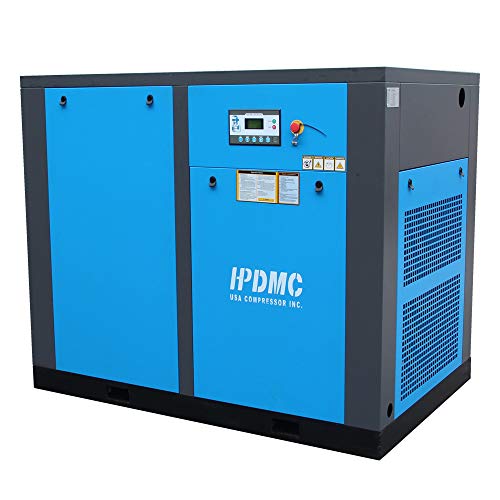
Introduction
Rotary screw air compressors are essential across various industries, providing the compressed air needed to power tools and equipment. Their significance extends to industrial manufacturing, construction, transportation, and even everyday applications. As a primary source of compressed air, these compressors enhance production efficiency and play a critical role in automation, energy conversion, and storage, among other applications.
Working Principle and Applications
How Rotary Screw Air Compressors Work
Rotary screw air compressors operate using two interlocking helical screws, known as rotors, to compress air. The process follows these steps:
1. Air Intake: The compressor draws air in through the intake side.
2. Compression: The rotating screws trap and move the air along their threads, gradually compressing it.
3. Lubrication & Cooling: Lubricating oil creates a hydraulic seal between the rotors, transferring mechanical energy while cooling and lubricating the components.
4. Air Discharge: The compressed air is released at the output end for use in various applications.
These compressors are widely used in industrial manufacturing, petrochemical industries, mining, and power generation due to their efficiency and ability to deliver continuous compressed air.
Key Specifications and Pricing
What is CFM?
CFM (Cubic Feet per Minute) measures the airflow rate of an air compressor, indicating the volume of air passing through the system per minute. It is a critical performance metric influenced by factors such as:
● Compressor model and design
● Rotational speed
● Screw diameter and length
Different rotary screw air compressors offer varying CFM ratings, such as 5 CFM, 6 CFM, 10 CFM, 20 CFM, and high-capacity models like 185 CFM.
What is SCFM?
SCFM (Standard Cubic Feet per Minute) represents the volume of compressed air delivered, adjusted to standard atmospheric conditions. This standardized measurement ensures that compressed air systems meet specific application requirements.
● Too low SCFM: May result in insufficient airflow, affecting equipment performance.
● Too high SCFM: Can cause energy waste and unnecessary costs.
What is HP?
HP (Horsepower) measures the power capacity of an air compressor’s motor, indicating how much work it can perform within a given timeframe.
● Higher HP: Allows the compressor to handle greater air volume and pressure.
● Lower HP: Suitable for lighter applications, reducing energy costs.
Selecting the appropriate HP rating is essential to balancing performance and cost efficiency.
What is PSI?
PSI (Pounds per Square Inch) measures the pressure exerted by the compressor during the compression process.
● High PSI: Increases output efficiency but may result in excess energy consumption.
● Low PSI: May not meet production demands.
Choosing the correct PSI rating based on specific application needs is crucial to optimizing performance and cost efficiency.
Cost-Performance Considerations
Rotary screw air compressors come in various models and configurations to meet diverse industrial needs. Generally, higher power and capacity lead to higher prices. Additionally, features such as energy-saving technology, low-noise operation, and intelligent control systems can add value but increase costs.
Buying Tips:
1. Clarify Your Requirements:
○ Determine the necessary power, capacity, working pressure, and airflow to avoid over- or under-investing.
2. Compare Models:
○ Within the same power range, evaluate different models for the best balance of price and performance.
3. Prioritize Energy Efficiency:
○ While energy-efficient models may have a higher upfront cost, they lead to long-term savings on electricity bills, improving overall economic benefits.
Recommended Models
● Budget Option: For users with limited budgets and moderate needs, consider mid-range power models such as the HPDMC Rotary Screw Air Compressor 5.5HP for an affordable yet efficient solution.
● High-Efficiency Option: For industrial operations requiring continuous use and energy efficiency, advanced models like the HPDMC Rotary Screw Air Compressor 75HP offer cutting-edge energy-saving technology and high performance.
Conclusion
When selecting a rotary screw air compressor, key factors to consider include power, brand, technical features, cost-effectiveness, and after-sales service. A clear understanding of application requirements and market price trends will help ensure a smart investment. Additionally, prioritizing energy efficiency and automation can improve production efficiency and overall economic returns.


